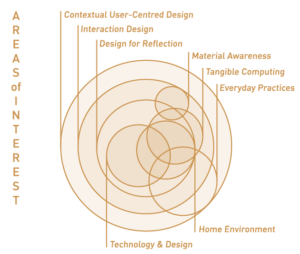“The aim of my projects is to create strategies to generate qualitative and meaningful interactions
between the user, the object and the context where the interactions happen“

My starting point is my background: after a Classical high school in Italy that gave me the foundation to analyze the context, I did my Bachelor in Design and Visual Communication at the Politecnico di Torino, in Italy, where I improved my technical and design skills. After the Bachelor focused on the role of aesthetics in design, I felt the need to learn how to design not only the appearance and the functionality of the product but also researching for deeper levels of interactions. The moment of use is part of the design cycle, and the designer has the role and the responsibility to create also the qualities of use of the object.
I like to define myself as a context exploring designer: I usually start every project with a deep and accurate research about the field and a thorough analysis of the context, I believe, indeed, that my role as a designer is to be able to interpret the needs of people through behavioral and contextual analysis. I involve the users throughout different phases of the design process, with different methodologies of qualitative research (ethnographic research[1], context-mapping[4], probe study[2], experience diary[3] and contextual interviews[3]).
I put the cultural sensitivity as a fundamental guideline in every project that I start, and I think that this comes from my bi-cultural background; I grew up in an Italian-Dutch family, and that gave me the sensibility to analyze every project with a double point of view. In my methodology, I usually start from a broad context, and through the research, I outline possible new directions that I can take from that topic. My design approach does not only start with a problem to be solved, but it also starts by looking for inspiration from the analysis of the context, talking with the users, trying to put myself in their shoes. I approach every new project as a learning experience, applying different methods both for the research phase both for the idea generation phase and finally for the user evaluation phase. My passion is to understand how the users interact with the context analyzed in the project, looking for needs and concerns observing the real world, and to observe how they interact and interpret new concepts, aiming at making their everyday life easier.
After the exploration part, the designer has to change his position from observer to problem solver, and in that moment I look for qualities that I can bring into my project. For me Progress means simplifying, not complicating; in every project, I maintain the curiosity of learning, the pleasure of understanding the world that we live in and the desire to communicate it with the people around me.
This is what design has to bring to users, an improvement of the qualities of interactions creating an immediate and natural conversation between the object and the user, in both directions. I desire to utilize design as an act of engagement, not to solving all the world’s problems but creating meaningful alternatives.

1. Blythe, M. and Monk, A. Notes Towards an Ethnography of Domestic Technology. In Proc. DIS'02, ACM Press (2002), 277–281. 2. Gaver, T. Dunne, E. and Pacenti, ‘Design: Cultural probes. interactions 6, 1 (1999), 21–29. 3. Patton, Qualitative evaluation and research methods, (1990), Beverly Hills, CA: Sage; 4. van der Burg, M. Verhoef, ‘‘Context mapping put into practice’’, (2010), Delft University of Technologies;
